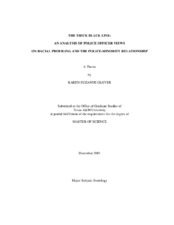| dc.description.abstract | Much research has been conducted on the police-minority relationship, primarily from the view of the civilian. As central actors, the police view is noticeably absent from the research. I employed in-depth interviews and open-ended survey questions of patrol officers and sergeants in the Novad Texas Police Department about their views on the police-minority relationship and racial profiling.
Through content analysis of the data, I examined two common themes that emerged from the discourse. The first was how "the past" was used to frame contemporary police-minority relations. The dominant narrative was that the historical police-minority relationship was something minorities should "get over" as those practices no longer applied to the current relationship. Counter views to this narrative acknowledged both past and present practices as influential.
The second theme that emerged during the discussion of racial profiling was the primacy of socio-spatial control, encapsulated in one officer's comment about a "white boy in a no white boy zone." For many of the officers, control of predominantly minority and predominantly white neighborhoods meant that individuals who "did not fit" those respective spaces were subject to increased law enforcement attention. The frequency of the "white boy in a no white boy zone" scenario specifically, and not the reverse scenario that currently charges the debate surrounding racial profiling, suggests that the officers were more comfortable discussing the sensitive issue of racial profiling in this manner.
Three additional areas were examined. The "out of place" doctrine evident in the officers' discussions of racial profiling creates a dilemma for the police officer because the doctrine may be considered both an effective police practice given current community policing initiatives and one that enforces the racial order in the United States. Secondly, statistical discrimination theory was employed by some of the officers to rationalize the targeting of minorities and minority space. Finally, some of the officers discussed the conflux of race/ethnicity with class, and viewed "profiling" of particular groups as based in socioeconomic status. | en |


